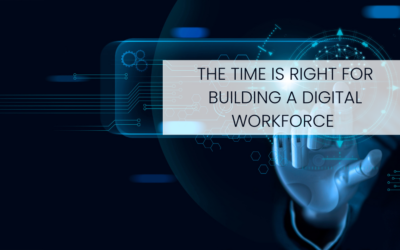The manufacturing sector is currently undergoing significant transformations.
As the global economy recovers from the impact of the COVID-19 pandemic, many countries are witnessing a resurgence in manufacturing activities, leading to a surge in investment in this sector.
The Manufacturing Supercycle has emerged as a significant driver of investment and a primary factor in the requirement for manufacturers to transform. This manufacturing supercycle is driven by growth in the manufacturing sector, increased consumer spending, infrastructure development, and government policies.
Another driving force behind these changes is the increasing importance of customer experience. Manufacturers are now expected to take responsibility for the consumer’s entire experience. This responsibility extends beyond quality assurance and includes catering to the end consumer directly.
The emergence of advanced technologies like artificial intelligence, machine learning, robotics, code manufacturing, and integrated workflow have revolutionized the processes, data pipelines, and overall operations in manufacturing.
Combined, the convergence of all these forces has created a sense of urgency for manufacturers to transform their operations and embrace digital technologies. With increased demand and competition, manufacturers are pressured to optimize their processes, increase productivity, and deliver products faster.
Digital transformation is crucial in achieving these objectives. By embracing these technologies, manufacturers can streamline their operations, reduce costs, improve product quality, and meet the growing demands of customers in a highly competitive market.
This article explores how ThoughtFocus can support your digital transformation and foster a seamless customer experience at every touchpoint along the manufacturing journey.
Four Important Technology Trends
The manufacturing industry is being significantly impacted by four technology trends.
DIGITAL TRANSFORMATION
To stay relevant, manufacturing companies have embraced digital transformation. Many manufacturers are redefining their identity as data companies producing tangible products.
AI, machine learning, IoT, and robotics are utilized in various operations such as research and development, production and assembly, order management, pick-and-pack, just-in-time inventory, logistics management, reverse logistics, and other essential functions.
The cloud is the great enabler. Cloud-based solutions are critical for advancements such as smart services, sustainability efforts, and a connected, transparent supply chain.
A cloud-based data platform can enable manufacturers to democratize data and bring together operations and information technology networks.
THE RETAIL INFLUENCE
Previously, manufacturers were disconnected from the end consumer, and retailers acted as connectors. Today’s consumers buy directly from manufacturers and understand their role in the supply chain and customer satisfaction.
The changing dynamics of the retail customer experience drove this cultural shift. The proliferation of omnichannel experiences in everyday life forced manufacturers to adopt more customer-centric tactics.
Retail customers now expect speed, convenience, real-time visibility into product and inventory status/location, fast delivery times, real-time communication, and a seamless end-to-end experience from manufacturers.
Retailers now rely on manufacturers to meet customer experience expectations, and, in turn, manufacturers need to align with those expectations.
All these create a ripple effect, and consumers are more inclined to hold manufacturers and the supply chain accountable for negative customer experiences rather than blaming the retailer.
AUTOMATION EVERYWHERE
Manufacturers have long deployed automation to make production more efficient. This continues with robotics and other automated systems. However, today manufacturers are fast becoming data companies — data informs and runs their processes, feedback loops, and production to the point where some manufacturers run autonomous assembly lines. Automation to this extreme requires data, applications, software, IoT, platforms, and systems to be integrated.
FLEXIBLE SUPPLY CHAINS
Now that the pandemic disruptions in the supply chain have eased and the prices of raw materials have declined, manufacturers are turning their attention back to growth and expansion. This means assessing what’s possible with new and emerging technology.
Many manufacturers are building tech platforms or partnering with software companies to transform customer experience and develop new innovative capabilities (such as predictive maintenance) to serve customers better. The entire retail and supply chain ecosystem expects greater innovation, visibility, connected systems, and automated real-time communication. Manufacturers that can’t meet that expectation will be left behind for those that can. It requires a supple, agile ecosystem.
PULLING EVERYTHING TOGETHER
Manufacturers actively adapt to these emerging trends to stay competitive and drive innovation by leveraging advanced technology.
Additionally, real-time data, driven by customer feedback and IoT, is crucial in informing product design and engineering, leading to innovative solutions.
Furthermore, data and automation facilitate more interactive engagements between manufacturers and end consumers, enhancing customer experiences.
Manufacturers continuously strive to leverage these new customer experiences, whether through direct-to-consumer channels or traditional retail. In terms of supply chain management, cloud-based and integrated order management systems, along with inventory management systems, enable seamless connectivity and real-time visibility for all supply chain members. This enhanced visibility allows for easy tracking of inventory status and enables proactive management of disruptions or delays through automated triggers and alerts. Ultimately, this visibility across the supply chain mitigates risks and enhances the ability to meet customer expectations.
With artificial intelligence, automated demand forecasting and production scheduling will change the game for many manufacturers.
Manufacturers can accurately track customer inventory and sales volumes by integrating data and systems, allowing for autonomous production planning. Real-time integration with suppliers enables an automated purchase order process, ensuring that inventory and material demands are met promptly. Cognitive supply chains utilize AI and automation to monitor supply and demand, automatically ordering more inventory when certain thresholds are reached. This streamlined approach creates a stable and predictable supply chain, guaranteeing that customer demand can be met efficiently.
The simple Bill of Materials is being extended into all parts of the organization. For example, by leveraging artificial intelligence (AI) and machine learning (ML), ThoughtFocus helps manufacturers create user manuals in PDF format by continuously reading databases and identifying relevant changes.
Manufacturers are now adopting predictive maintenance and operations protocols alongside demand forecasting to enhance their efficiency. By proactively alerting end users about potential issues, unexpected disruptions to equipment or systems can be prevented. This proactive approach also extends to consumers, such as in the auto industry, where manufacturers take on the responsibility of notifying customers about maintenance needs. Fueled by IoT and performance data, predictive analytics provide valuable insights that inform demand forecasting. This enables manufacturers to anticipate end-of-life or replacement needs, enabling them to produce the required products even before the customer realizes it. This customer-centric approach is a significant advantage of predictive analytics in the manufacturing industry.
THINKING ABOUT THE FUTURE
The role of IT in the manufacturing industry is crucial in shaping its future. With the increasing importance of data and technology, manufacturers are transforming into data companies. To effectively respond to these trends, IT is adopting platform engineering approaches to standardize technology and create common tools across the organization. This not only brings stability and cost reduction but also enables faster and more efficient innovation. Additionally, continuous customer experience, driven by automation and predictive analytics, ensures a seamless and personalized experience. Artificial intelligence and automation are essential for various processes, from predictive analytics to streamlining operations. Real-time integrations, especially in cloud systems, are vital for creating a connected and transparent ecosystem. By automating the integration process, manufacturers can simplify and enhance their operations.
Cloud-based solutions and integration are crucial for enhancing efficiency and connecting systems, applications, tools, and resources. The post-COVID era has further emphasized the need for a supple ecosystem and greater innovation within the industry.
Manufacturers adapt to these trends by leveraging advanced technology to stay competitive and drive innovation. Real-time data and automation are crucial in informing product design, enhancing customer experiences, and enabling seamless connectivity within the supply chain. Manufacturers are adopting predictive maintenance and operations protocols alongside demand forecasting to enhance efficiency and proactively address potential issues. IT plays a crucial role in shaping the future of the manufacturing industry, with a focus on data and technology. Platform engineering approaches, automation, and real-time integrations are key strategies for manufacturers to stay ahead in this evolving landscape.
In conclusion, manufacturers must continue to embrace digital transformation and leverage advanced technologies to meet customer expectations and drive innovation. Cloud-based solutions and integration are essential for creating a connected ecosystem that enhances efficiency and transparency. The post-COVID era has further emphasized the need for innovation and a supple ecosystem within the industry. Manufacturers can proactively address issues, optimize their operations, and deliver a seamless and personalized customer experience by adopting predictive analytics, automation, and real-time integrations. IT plays a crucial role in shaping the future of the manufacturing industry, and manufacturers must continue to prioritize data and technology to stay competitive in the modern, high-tech manufacturing landscape.



